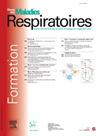Applying single cell profiling to assess drug anti fibrotic properties in the human precision cut lung slice model of fibrosis
IF 0.5
4区 医学
Q4 RESPIRATORY SYSTEM
引用次数: 0
Abstract
Much of our understanding of pulmonary fibrosis has been derived from mechanistic observations from animal models and many of the drugs currently studied were developed with very limited preclinical evidence for relevance to the human disease. Here, as part of the Pulmonary Fibrosis Connectome Project we used human precision lung cut slices (PCLS) and single nuclear RNA sequencing (snRNAseq) to determine the effect of several compounds targeting key fibrotic pathways and validating drugs predicted as anti-fibrotic.
Methods
Four PCLS slices per control donor (n = 2) at day 5 after DMSO, FC, FC + treatment were washed in cold 1X PBS and snap frozen. Fibrotic Cocktail (FC) contained TGFb, TNFa, PDGF and LPA, for 5 days, as previously described 1. Treatment included IPF FDA-approved drugs (Nintedanib), as well as drugs currently in clinical trials. Single nuclei suspensions were barcoded using the 10x Chromium Single Cell platform, cDNA libraries generated and sequenced on Illumina platform and integrated together using RCPA. To build the heatmap we calculated the average mean expression of gene of interest within each cell type and across the different conditions.
Results
250,000 single nuclei transcriptomes obtained from 2 donors (2 PCLS per condition, 9 conditions) were analyzed. Fibrotic cocktail stimulation induced the emergence of aberrant basaloid cells (Panel A). No treatment stimulation influenced cell type proportions (Panel B). However, several treatments significantly affected the gene signature of fibroblast and aberrant basaloid cells signature, including Verteporfin, and FDA approved drug targeting YAP-TEAD signaling. Verteporfin led to a significant decrease of ECM or profibrotic genes such as MMP1, TNC, FN1, COL6A6, SERPINE1 and CDH2 (Panel C). In addition to the gene expression changes, preliminary and ongoing ligand receptor analysis suggests treatment condition significantly modified cellular connectivity of the aberrant basal cells in particular with the alveolar epithelial cells, as compared to the fibrotic condition (Panel D) (Fig. 1).
Conclusion
Applying SnRNA seq to PCLS treated with drugs is an innovative and promising model to assess and potentially predict drug efficacy in human tissues, at a cellular resolution on both abnormal cell populations and cell specific fibrotic gene expression patterns and connectivity.
应用单细胞谱法评估人体精确肺切片纤维化模型中药物抗纤维化特性
我们对肺纤维化的了解大多来自动物模型的机制观察,目前研究的许多药物与人类疾病相关的临床前证据非常有限。在这里,作为肺纤维化连接组项目的一部分,我们使用人类精确肺切片(PCLS)和单核RNA测序(snRNAseq)来确定几种靶向关键纤维化途径的化合物的作用,并验证预测为抗纤维化的药物。方法在DMSO、FC、FC +处理后第5天,每个对照供体4片PCLS切片(n = 2),用1X PBS冷洗并快速冷冻。纤维化鸡尾酒(FC)含有TGFb, TNFa, PDGF和LPA,持续5天,如前所述1。治疗包括IPF fda批准的药物(尼达尼布),以及目前正在临床试验的药物。利用10x Chromium单细胞平台对单核悬液进行条形码编码,在Illumina平台上生成cDNA文库并进行测序,利用RCPA进行整合。为了构建热图,我们计算了每种细胞类型和不同条件下感兴趣的基因的平均表达量。结果分析了来自2个供体(每种情况2个PCLS,每种情况9个)的25万个单核转录组。纤维化鸡尾酒刺激诱导异常基底细胞的出现(图A)。没有治疗刺激影响细胞类型比例(图B)。然而,几种治疗显著影响成纤维细胞的基因特征和异常基底细胞特征,包括Verteporfin和FDA批准的靶向YAP-TEAD信号的药物。维替波芬导致ECM或纤维化基因显著减少,如MMP1、TNC、FN1、COL6A6、SERPINE1和CDH2(图C)。除了基因表达改变外,初步和正在进行的配体受体分析表明,治疗条件显著改变了异常基底细胞的细胞连接,特别是与肺泡上皮细胞的连接。结论将SnRNA测序应用于药物治疗的PCLS是一种创新的、有前景的模型,可以在细胞分辨率上评估和潜在地预测人体组织中的药物疗效,包括异常细胞群和细胞特异性纤维化基因表达模式和连通性。
本文章由计算机程序翻译,如有差异,请以英文原文为准。
求助全文
约1分钟内获得全文
求助全文
来源期刊

Revue des maladies respiratoires
医学-呼吸系统
CiteScore
1.10
自引率
16.70%
发文量
168
审稿时长
4-8 weeks
期刊介绍:
La Revue des Maladies Respiratoires est l''organe officiel d''expression scientifique de la Société de Pneumologie de Langue Française (SPLF). Il s''agit d''un média professionnel francophone, à vocation internationale et accessible ici.
La Revue des Maladies Respiratoires est un outil de formation professionnelle post-universitaire pour l''ensemble de la communauté pneumologique francophone. Elle publie sur son site différentes variétés d''articles scientifiques concernant la Pneumologie :
- Editoriaux,
- Articles originaux,
- Revues générales,
- Articles de synthèses,
- Recommandations d''experts et textes de consensus,
- Séries thématiques,
- Cas cliniques,
- Articles « images et diagnostics »,
- Fiches techniques,
- Lettres à la rédaction.
 求助内容:
求助内容: 应助结果提醒方式:
应助结果提醒方式:


